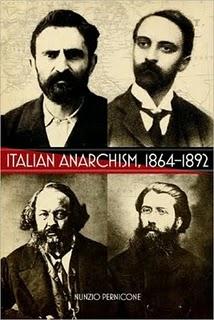Italian Anarchism, 1864-1892

Armed with footnotes and provisioned with a healthy bibliography, Italian Anarchism, 1864-1892 is not an easy read for the casual reader, or even the casual “antiauthorian leftist.” Isn’t that the euphemism for anarchist these days? Still, I don’t regret the time I spent reading—insurrection after insurrection, congress upon congress—the nearly 300 pages of text in Nunzio Pernicone’s history of these three decades. He writes not just about heroes like Errico Malatesta, but introduces the reader to supporting characters as well.
As an Italian-American who doesn’t even know her father’s real last name, I’ll admit I checked the index first, for Rossi, Russo, Rosso, anything that might have been shortened to our “boat name,” Ross. During these years my Italian grandfather (or was it his father?) immigrated to the United States, for lots of good reasons, as cataloged by Pernicone: the brutal introduction of capitalist farming methods, famine, and a cholera epidemic. I met Giovanni Russo, region of origin unspecified, who immigrated to Brazil and started an anarchist colony. Alas, I learned also that the Calabria, where my dad’s folks originated, was generally not in the vanguard during these turbulent times in Italy. I fear my ancestors really were the backward peasants the anarchists tried to energize.
But let’s move from mere genealogy to history. Not just women’s history has been “stolen from us,” and I am very grateful to AK Press for publishing this and other works of anarchist history and philosophy. It was almost as true in my young adulthood as it was for the “anarchist prince” Peter Kropotkin that one had to read about anarchism piecemeal in pamphlets. And of course, the reports of police agents are often the only written documents for historical research, as a glance at the footnotes and bibliography in the book reveals.
If we are patient readers, Pernicone’s friendly but balanced, serious, well-documented history fills a need for those of us on the left who are not “anarchist studies” specialists. It occasionally strikes a light, even humorous and lovingly critical, tone. The story about the overweight Michel Bakunin, Russian but the father of Italian anarchism, and his extrication from a carriage on an escape from Italy made me laugh out loud.
Without getting into the learning-from-and-repeating history discussion, the gifts of this book are numerous: the reader can actually feel the pressure militants exerted on themselves and their recruits to stage insurrection after insurrection even in the face of serious repression, understand the betrayal comrades felt when Andrea Costa “sold out” to become a politician, and appreciate the contingencies of history (i.e., how things might have gone another way). After all, anarchism was once a popular movement not just in Italy, and helped set the agenda for socialist activism, but like all movements it was composed of human beings with flaws as well as strengths.
How was this powerful international movement pushed to the fringe and then outside the boundary of political discourse, trivialized as a frivolous critique of organization, or slandered as the equivalent of terrorism in contemporary metropolitan dailies? Sometimes it is easier for feminists and participants in other contemporary movements to open our minds about own activism and the way forward by reading and thinking about a history a bit more distant and “other” than the anti-globalization actions in Seattle in 2000. Pernicone provides us with a history and leaves drawing parallels with contemporary times to the reader.
Do the multiplicity of newspapers started by Italian anarchists suggest a similarity to our current reliance on the Internet? Are activists today missing the boat as anarchists of this period did with early labor organizing? Read and learn.